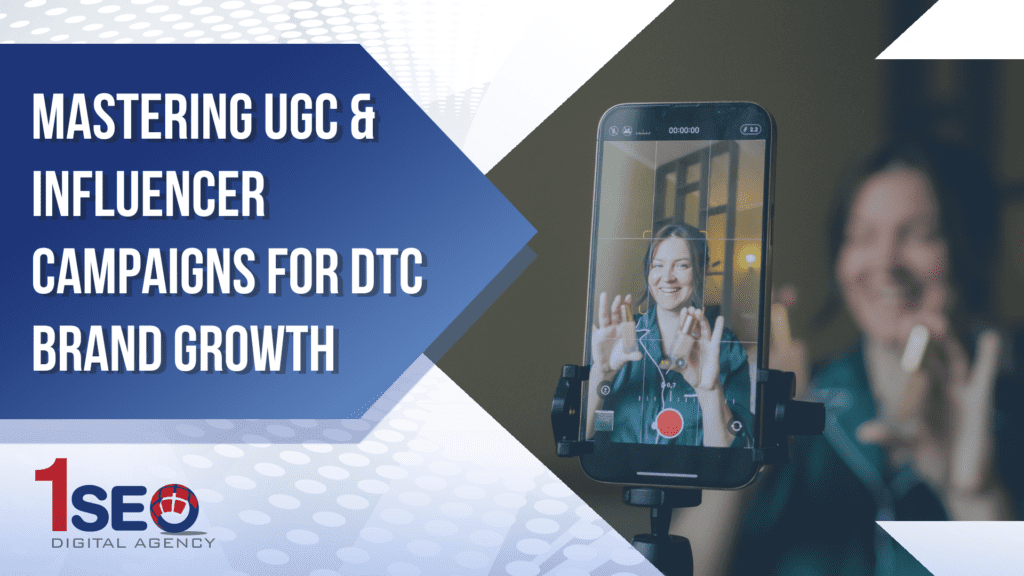Speak To An Expert Now: 215-946-1046

Effective Marketing Strategies for Roofers
Are you a roofer looking to expand your customer base? Now more than ever, digital marketing strategies are vital in gaining visibility in the industry

In today’s digitally connected marketplace, direct-to-consumer (DTC) ecommerce brands thrive on authenticity, trust, and engagement. The internet has reshaped the traditional customer journey, placing immense value on social proof, word of mouth, and credibility. User-generated content (UGC) and influencer marketing have emerged as indispensable tools for ecommerce marketing, providing brands with a powerful way to build brand awareness, boost customer loyalty, and drive conversions.
As ecommerce brands navigate the ever-evolving digital marketing landscape, understanding the strategic integration of UGC and influencer campaigns becomes critical. These marketing strategies not only strengthen a brand’s reputation but also influence consumer behaviour, enhance search engine optimization (SEO), and contribute to a seamless customer experience across various touchpoints.

User-generated content (UGC) refers to any content—images, videos, reviews, or social media posts—created by consumers rather than the brand itself. This form of generated content acts as a form of digital word of mouth, often more persuasive than traditional advertising. UGC campaigns capitalize on real customer experiences to build confidence, increase customer satisfaction, and foster community engagement.
Influencer marketing, on the other hand, involves partnerships with individuals who have cultivated a loyal audience on social platforms. These influencers act as brand ambassadors, promoting products in a way that feels organic and trustworthy. The authenticity and storytelling embedded in influencer content can significantly enhance brand visibility and resonance with a target audience.
In a crowded digital ecosystem, authenticity is currency. UGC offers ecommerce brands an affordable and scalable way to produce credible, authentic content that resonates with their audience. When consumers share their stories, photos, or testimonials, it lends credibility to the brand’s message and encourages other users to engage.
This type of content fosters brand loyalty by making consumers feel valued and heard. Featuring UGC on product pages, social media accounts, or newsletters can improve conversion rate optimization by creating a sense of trust and relatability. It also contributes to customer retention, as satisfied users are more likely to become repeat customers and advocates within the brand community.
Influencers are modern-day storytellers who translate brand values into engaging narratives. DTC ecommerce brands benefit from influencer marketing by tapping into pre-established communities that align with their target audience. The credibility of an influencer’s voice, coupled with their deep understanding of their audience’s preferences, makes them effective partners in driving sales and boosting online shopping engagement.
Campaigns that include influencers can reach new demographics, enhance customer lifetime value, and provide rich data for analytics. Successful influencer collaborations hinge on alignment in values, aesthetics, and messaging, ensuring that the advertising campaign feels organic and not overly commercial.
The synergy between UGC and influencer marketing creates a cohesive content strategy across channels. When brands repurpose influencer content as branded content on landing pages, email marketing campaigns, and even mobile apps, they reinforce a consistent narrative that strengthens brand perception and recall.
This omnichannel approach enhances the overall customer experience, allowing consumers to interact with authentic content at every stage of their journey—from discovery to purchase. It also supports personalization efforts by delivering relevant, user-focused messaging based on behavior and preferences captured through analytics and social listening tools.
Social platforms like Instagram, TikTok, and YouTube are fertile grounds for UGC and influencer content. Hashtags, tags, and mentions serve as tools to aggregate content, increase visibility, and engage social media users. Encouraging followers to share their experiences using branded hashtags or participate in challenges can generate massive volumes of UGC that can be repurposed for broader campaigns.
Moreover, platforms like YouTube Shorts and Instagram Reels offer opportunities for short-form video content that drives engagement and improves SEO. This type of social media content helps build an engaged community and adds value to the brand’s social media marketing efforts.
To maximize the impact of UGC, brands need a robust content marketing strategy. This includes content moderation to ensure quality and alignment with brand values, optimizing content for the search engine to boost visibility, and using A/B testing to determine which types of UGC drive the highest conversion rates.
Ecommerce brands should strategically place UGC on product pages, reviews sections, and homepage banners to influence purchasing decisions. Tools like automation software and UGC platforms streamline the collection, curation, and distribution of content, ensuring consistency and compliance with consent and copyright guidelines.
The customer experience extends beyond a transaction—it encompasses every interaction a consumer has with the brand. UGC enhances this experience by making consumers feel part of a larger community. When users see real people using and loving a product, it creates a sense of inclusion and inspires confidence.
Incorporating UGC into customer service, such as using testimonial videos in help centers or displaying UGC photos in FAQ sections, adds a human touch. Brands can also use UGC in email marketing campaigns to drive opens and clicks, showcasing relatable experiences that guide potential customers through the funnel.
Understanding consumer behavior through data is essential to optimizing UGC and influencer campaigns. Google Analytics and other analytics tools offer insights into which content drives traffic, sales, and engagement. This information enables brands to personalize their content, offers, and messaging to meet specific audience needs.
By segmenting customers based on their interactions with UGC and influencer content, brands can deliver tailored experiences that improve ROI and customer satisfaction. Personalization boosts the relevance of content and makes the customer feel seen, increasing the likelihood of conversion and upselling.
Loyalty programs that reward customers for sharing content create a cycle of engagement and advocacy. Offering incentives like discounts, early access, or loyalty points in exchange for reviews, photos, or social media posts can encourage more users to contribute. This not only enriches the brand’s content library but also strengthens brand loyalty.
Gamifying UGC submissions—such as hosting photo contests or tagging campaigns—enhances participation and builds excitement. These loyalty-driven UGC campaigns serve dual purposes: enriching content creation and reinforcing consumer engagement.
As ecommerce continues to evolve, technology plays a pivotal role in shaping UGC and influencer strategies. Artificial intelligence enables smarter content moderation, predictive analytics, and automated workflows. Virtual reality and augmented reality tools allow users to visualize products in immersive environments, leading to higher engagement and reduced returns.
Headless commerce platforms provide greater flexibility in integrating UGC into various parts of the shopping experience. Similarly, mobile apps with UGC submission features empower users to contribute content seamlessly, turning every customer into a potential content creator and advocate.
UGC and influencer content have a significant impact on a brand’s online reputation. Proactive reputation management involves monitoring reviews, social media mentions, and user feedback to identify trends and areas for improvement. Social listening tools help brands stay attuned to consumer sentiment, allowing them to respond quickly and authentically.
Managing the narrative across all media channels—whether through direct engagement, UGC promotion, or influencer collaborations—protects the brand’s image and ensures that its voice remains consistent and positive across the world wide web.
Brands that prioritize UGC and influencer marketing are not just promoting products—they’re cultivating communities. By fostering two-way conversations, sharing consumer stories, and investing in authentic relationships, DTC ecommerce brands transform customers into advocates and brand ambassadors.
These efforts translate into long-term gains in brand equity, customer lifetime value, and market share. The UGC ecosystem creates a flywheel effect: more engagement leads to more content, which leads to more visibility, credibility, and ultimately, more sales.

As UGC continues to power ecommerce marketing strategies, it’s essential for brands to navigate the legal landscape responsibly. The rise of social media content has led to a blurred line between public sharing and brand-owned content, making copyright infringement, consent, and content moderation critical areas of concern. Brands must ensure they have explicit permission to use UGC, whether it’s photos, videos, or testimonials.
Clear guidelines and terms of use should be established to protect both the user and the company. These agreements should outline how UGC will be used across websites, mobile apps, and advertising campaigns, ensuring compliance with digital marketing laws and safeguarding against potential reputation damage. Reputation management extends beyond reviews and influencer statements—it involves proactively mitigating legal risks while fostering consumer trust and authenticity.
Efficient UGC and influencer marketing campaigns require sophisticated tools and software to streamline content creation, manage assets, and analyze performance. Brands leveraging UGC platforms like TINT, Yotpo, or Later can automate UGC collection from social media users, moderate submissions, and publish content directly to product pages and landing pages.
Similarly, influencer marketing tools such as Aspire, CreatorIQ, and Upfluence provide end-to-end management for brand collaborations. These platforms help ecommerce brands identify relevant influencers, track analytics, manage communication, and assess the return on investment of each partnership. Automation tools also ensure scalability without sacrificing content quality, enabling businesses to handle large volumes of generated content across all marketing channels.
Artificial intelligence is transforming how brands manage and scale their UGC efforts. AI-powered systems enhance information retrieval, enabling marketers to quickly find high-performing content across social media platforms, forums, and video sites like YouTube Shorts. AI also improves content moderation by detecting inappropriate material and maintaining brand safety.
AI-driven analytics tools offer predictive insights into consumer behavior, helping brands personalize messaging and determine the most effective touchpoints for engagement. Whether it’s optimizing mobile experiences, curating personalized product pages, or identifying trends across social networks, AI enhances every stage of the UGC lifecycle. For ecommerce businesses, this means higher conversion rates, improved user experience, and greater customer satisfaction.
Integrating UGC into paid media significantly enhances the impact of advertising campaigns. Authentic visuals, testimonials, and ugc videos increase relevance and credibility, outperforming traditional branded ads on metrics like click-through rate and engagement. Platforms like Meta, TikTok, and Pinterest reward brands that incorporate authentic content, making UGC an indispensable part of an effective digital marketing strategy.
By running A/B tests with UGC versus studio-created ads, brands can refine their advertising strategy and drive better results across social commerce, email marketing, and online shopping touchpoints. Combining this with targeted landing page experiences and mobile app retargeting boosts not only visibility but also sales and customer retention. As consumer expectations evolve, relatable and real content consistently wins.
At the heart of every successful UGC campaign is a thriving brand community. Ecommerce businesses that encourage interaction through hashtags, contests, and shared stories build meaningful relationships with their audience. These communities become powerful ecosystems of advocacy, loyalty, and conversation, all driven by shared values and consistent engagement.
When consumers feel part of a movement, they become invested in the company’s success. Highlighting UGC on your website, in your newsletter, or across your social media accounts demonstrates appreciation and deepens emotional connections. In turn, these efforts increase customer lifetime value and spark additional word of mouth. Brands like Glossier exemplify this approach by letting their users shape the narrative through shared ugc photos, reviews, and tutorials.
Data-backed decision-making is critical for scaling successful ugc campaigns and influencer partnerships. By tracking key metrics such as engagement rate, conversion rate, and customer acquisition cost, brands can calculate the true value of their efforts. Platforms like Google Analytics, HubSpot, and Shopify provide robust analytics that break down traffic sources, sales influenced by UGC, and customer behavior patterns.
Understanding these data points helps refine your content marketing strategy, improve personalization, and boost customer experience across all digital touchpoints. Brands should also track qualitative data—such as sentiment analysis and brand perception—to gauge the intangible benefits of ugc social media campaigns. When combined, these insights guide smarter investment, more effective content creation, and stronger campaign outcomes.

As DTC ecommerce brands look to master the art and science of UGC and influencer marketing, partnering with the right digital agency can make all the difference. 1SEO Digital Agency stands out as the go-to expert for ecommerce businesses seeking to elevate their digital marketing strategy and maximize return on investment. With a proven track record of helping online retailers build powerful brand communities, increase sales, and improve customer experience, 1SEO offers the full spectrum of services tailored to meet the dynamic needs of today’s ecommerce landscape.
Our team specializes in social media marketing, expertly managing UGC campaigns, influencer partnerships, and brand storytelling across top social media platforms. We build cohesive content marketing strategies that incorporate content creation, social proof, and testimonial marketing to drive authentic engagement and credibility. Our SEO services ensure your UGC and branded content are discoverable on every major search engine, while our conversion rate optimization and web design teams focus on enhancing product pages, landing pages, and overall user experience to convert traffic into loyal customers.
In addition to these core services, 1SEO provides expert reputation management, email marketing, and omnichannel campaign execution, giving your brand the tools it needs to dominate across every marketing channel. With powerful analytics, AI-driven insights, and a deep understanding of consumer behavior, we help ecommerce companies scale efficiently and sustainably in a highly competitive market.
At 1SEO Digital Agency, we don’t just execute marketing—we build ecosystems that transform brands into market leaders. Contact us today to start building your ecommerce success story.

Are you a roofer looking to expand your customer base? Now more than ever, digital marketing strategies are vital in gaining visibility in the industry

Artificial Intelligence is revolutionizing how we interact with technology. AI-powered chatbots like OpenAI’s ChatGPT and Google’s Gemini are at the forefront of this shift, demonstrating